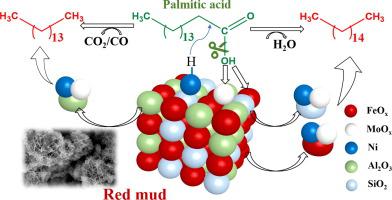Our official English website, www.x-mol.net, welcomes your
feedback! (Note: you will need to create a separate account there.)
通过对亲氧 MoOx 物种进行表面修饰,合理控制棕榈酸在 Ni/红泥催化剂上的加氢脱氧路径
Fuel ( IF 6.7 ) Pub Date : 2022-08-03 , DOI: 10.1016/j.fuel.2022.125447 Qi Wang , Xingyong Li , Jinyi Duan , Jinlei Chen , Yueyuan Ye , Dechao Wang , Shuirong Li , Zhifeng Zheng

|
已经探索了赤泥负载的 Ni (Ni/RM) 催化剂用于棕榈酸的加氢脱氧 (HDO),然而,脱羰基化 (DCO)/脱羧 (DCO2) 占主导地位。因此,催化剂亲氧性质的改性会显著影响其 HDO 路径和对目标产物的选择性。在此,制备了具有多级花状微/纳米结构的 MoOx 修饰的 Ni-Mo/RM 催化剂,并将其应用于棕榈酸的 HDO。研究了 MoOx 添加对 HDO 路径的控制作用,导致产物碳数分布的变化。结合几个全面的结构表征和催化 HDO 测试,表明表面缺陷的 MoOx 种类和金属位点附近的 FeOx 种类可以显着促进 C-O 键的弱化,产生更直接的脱氧产物(十六烷)。而过量的 Mo 负载导致表面化学性质的明显改变(即比表面积、孔体积和 Mo0 种类的减少、还原温度和 CO2 吸附的增加、Ni 种类的分散不均匀和团聚),导致棕榈酸转化率降低。作为 RM 中的主要氧化物,Fe2O3、Al2O3 和 SiO2 分别以 Fe2O3、Al2O3 和 SiO2 为载体负载 Ni-Mo 双金属,探究 RM 中不同组分对棕榈酸加氢脱氧产物分布的贡献。

"点击查看英文标题和摘要"





















































 京公网安备 11010802027423号
京公网安备 11010802027423号